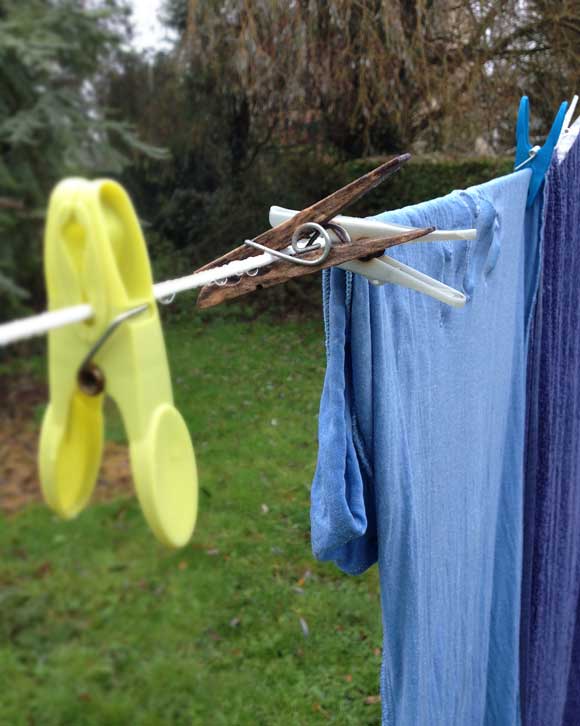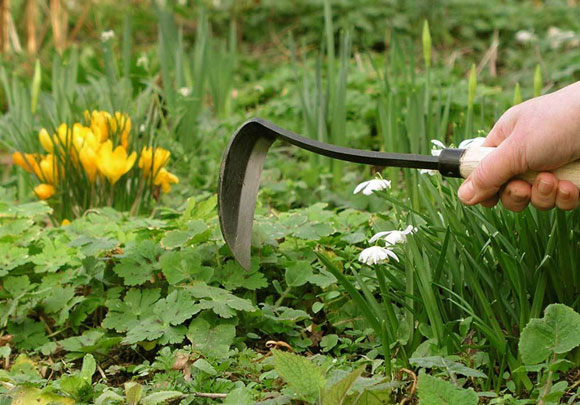The so-called greenhouse effect is essentially the trapping of reflected solar energy (infra-red radiation) by ‘greenhouse gases’. We actually need greenhouse gases in our atmosphere, otherwise the average temperature on earth would be about -18°C and so too cold for life. Unfortunately, in the last 200 years or so, human activities like the burning of fossil fuels have pumped huge amounts of extra greenhouse gas into the atmosphere, enhancing the greenhouse effect and so warming up the planet. Continue reading
Author Archives: Issi
Wash day blues – Getting the washing dry when it’s raining
I know I’m not alone in loving a dry day when I can hang my washing to dry outside on the line. There is something satisfying in seeing towels and sheets blowing around and not using any energy other than the wind or sun. It makes me feel happy! So what happens when it’s pouring with rain, just drizzling or is damp and foggy and nothing will dry? The options are:
a) get out the clothes airer turn on the heating and load all your radiators with wet washing. – Clothes might dry a bit stiff, and can create a damp atmosphere and associated health risks particularly for those with asthma or other allergic conditions;
b) Use a ‘Sheila’s maid’ or retractable clothes line in the garage, carport or porch – clothes might get a dry eventually!
c) Load it all into the tumble dryer, if you’ve got one, and worry about the energy costs later. (Check the running costs on Sust-it)
There are other options such as plug-in airers – however these potentially have the same issues as drying clothes on radiators – the moisture has to go somewhere. A Rotaire Dryline (a rotary washing line with a cover), might offer a good solution if it the weather is initially dry but rain is forecast. You could also bag your washing up and take a trip to the local launderette – remembering to take a bag full of coins to feed the dryer.
Whatever, it’s a dilemma and I can understand the wash day blues, (cue Dolly Parton), and really admire how past generations coped. Perhaps we should put more emphasis into designing clothes that need washing less or that are quicker to wash and dry. Never mind Smart TVs – Smart clothing is what we need!
Climate Change Summit
Here we go again – another summit on Climate Change. This follows a day of action yesterday, The People’s Climate March, that saw street protests in London, New York and a staggering 2,000 locations across the world, all demanding urgent action on climate change. Reportedly attracting hundreds of thousands of marchers.
The UN will host a climate summit at its headquarters in New York with 125 heads of state and government to be present. This is the first summit since the climate conference in Copenhagen in 2009, which was not successful in securing progress on a universal agreement on emissions reductions. Let’s hope this time the science is listened to too.
Can’t see the wood for the trees? – Forestry Commission launches new app
For many of us it’s difficult enough identifying fully grown trees let alone identifying young trees or shrubs in a woodland setting; a problem woodland managers, foresters, ecologists and the like have grabbled with for years – how do you identify which naturally established plants you want to keep and which ones to remove? Now the Forestry Commission has turned to a technical solution to help in woodland management. It has just launched an app at the Forest Research show. Forestry Commission’s Matt Parratt said ” …..The app allows people to quickly and accurately identify self-set trees and shrubs regardless of their age. They can also record field notes and locations using GPS without a mobile signal. This is always going to be more efficient and helpful than revisiting a site”. So potential carbon savings there too. The app costs £1.49 and can be downloaded from the AppStore and Google Play.
Does a blaze of berries signal a hard winter ahead?
The combination of a wet spring and a sizzling summer seems to have encouraged a particularly large crop of berries of all types this year. Blackberries, elderberries, damsons, sloes, rosehips and haws drip from the hedgerows providing a beautiful show and plenty of food for the birds. As the indian summer continues – the thought of winter seems a long way off – and mercifully no need to turn the central heating on yet, and long may it last. However, should we worry that a long cold winter is ahead of us? Well, apparently, whilst folklore and old wives tales might have us believe it, there doesn’t seem to be much scientist evidence to link an abundance of berries with weather conditions. There does, however, appear to be more evidence that berries are good for our health – although may be not when made into sloe gin, damson jam or blackberry and apple crumble! However, damson puree is really good on porridge… recipe below.

Damson puree recipe
- 600g damsons
- 200g caster sugar
- Water to cover
Put the damson and sugar in a pan and cover with water. Bring to a gentle simmer and cook for 30-40 mins (keep an eye on it to check that it doesn’t burn – more water can be added if necessary). Cool and then remove stones – they should have separated but lots of recipes claim the stones should pop to the top – they don’t all obey and it’s all a bit messy – pick out what you have the patience to do and them resort to a sieve (still a bit laborious – but worth it). Check the sweetness and add more sugar if necessary.
Either store in the fridge or if you are making greater quantities – bottle in jars, or freeze.
Great on pancakes, poured over ice-cream, or used in cakes.
Energy focused social investment fund Ignite announce its ‘Big Energy Idea’ winners
Ignite yesterday announced the names of 10 successful entrepreneurs who they will be working with to tackle energy challenges, and make real, sustainable change in communities.
- The Big Energy Idea will provide 10 social entrepreneurs with an individual package of investment readiness support and the potential to access a minimum £50,000 investment over the next year
- 10 successful ‘Big Energy Ideas’, including local business Sust-it were announced on 30th April, at an event held in Windsor
- The Big Energy Idea is run by Ignite, a fund that will invest £10 million over 10 years, backed by Centrica
Among the winners is Ross Lammas, founder of Sust-it, a family-run price comparison site that enables consumers to make informed buying choices based on energy usage and running costs of electrical products.
An individual package of support will be provided to the social entrepreneurs, Ross included, helping them gain investment and grow their ventures. The fund has been established by Ignite Social Enterprise, a social investment fund backed by Centrica plc, which is focused on energy-related businesses and enterprises.
As part of the tailored business support on offer (which brings together industry expertise from The Henley Business School, The Good Analyst, UnLtd and confidence coach Peter Nicholas) the primary objective will be to get each venture investment ready in order to grow its social impact. The businesses will be able to gain access to between £50,000 and £2 million from the Ignite fund.
Ross Lammas of Sust-it, said: “Becoming one of the successful Big Energy Ideas will make a huge difference to us. We’ll get additional expertise from the energy industry to build our future strategy, and hopefully, investment at some point in the next year. This will enable us to help those on low income save money and also to improve everyone’s energy literacy.”
Centrica CEO Sam Laidlaw, who announced the winning ideas, said: “I believe that the answers to society’s challenges do not lie solely with the private sector or the public sector, but with social entrepreneurs, in communities, and in cross-sector partnerships. I am passionate about the potential of each of these business – supported by us – to find some of these answers.”
Ignite is investing time, money and support into energy-related social enterprises, and is aiming to invest a minimum £10 million over 10 years with investments ranging between £50,000 and £2 million. The profits from Ignite’s investments will be reinvested and recycled back to help more social enterprises and ventures grow and scale up their work. Ignite has already committed £3.4 million of the fund across four projects that will be creating social change in the UK.
How to spot Ash dieback?
Out walking the dog this morning, I thought I would look for how many ash trees I could spot along my usual route and imagine the impact on the landscape if they fell prey to ash dieback fungal disease or Chalara fraxinea to give it it’s proper name. Ash dieback, has been found across Europe since it was first identified in 1992 after a large number of ash trees in Poland were reported to have died. If it takes hold in the UK, it could have a devastating impact on our countryside as ash is our third most common species of broadleaf tree, and provides an important habitat for flora and fauna. It is quicker growing than oak. So over the short distance of my walk I spotted at least eight mature trees, and one that appeared dead, it looked as though it had been dead for some time, but how would I know if had ash dieback? What do the symptoms of ash dieback look like? Time to consult the Woodland trust website. Helpfully they have a video showing the symptoms of Chalara fraxinea on young saplings, and a leaflet with photographs of the disease on mature trees, which I will consult in more detail. The government have been criticized for not acting quickly enough to ban imports of ash trees, as the Horticultural Trade Association raised this as a serious issue in 2009.
The government have been criticized for not acting quickly enough to ban imports of ash trees, as the Horticultural Trade Association raised this as a serious issue in 2009. This isn’t, of course, the only disease to threaten our native species Sudden Oak Death (Phytophthora ramorum) was first recorded in the UK in 2003, and Natural England have a list of over 30 plant diseases of pests that may require intervention in order to protect England’s biodiversity. In September 2012 Natural England established a plant disease and pest prevention control scheme. Let’s hope it isn’t too late.
How can you reduce your energy bills?
Now that the clocks have changed and the chances of a late Indian summer diminished, thoughts of staying warm and saving money come to mind. And whilst high energy prices rather than the worry of climate change may be the main motivator in reducing our energy bills, for some, reducing their ‘carbon footprint’ will be what it’s all about. So, it won’t be saving money in order to afford flying to a ski resort in the Alps, it’s about looking at the bigger picture and reducing our overall impact. The complexities of how you can develop a thriving economy whilst reducing our carbon emissions are for those with bigger brains than mine, but it seems not Lord Heseltine’s: “No stone unturned in the pursuit of growth” makes no mention of the need to create a greener economy – not even the words “green shoots” appear!
And it’s surprising how much energy we still waste, and at the same alarming that people are scared to use their heating because of cost. So what can you do to reduce your energy usage? Nothing revolutionary to offer here, just some suggestions…..
Stop the heat escaping if you can – free loft insulation is still available in many areas.
- Check draughts around doors and windows and fit draught excluders
- Turn off appliances and lights when not in use and don’t forget all those ‘phone and laptop chargers left plugged in.
- Try to use appliances such as dishwashers and washing machines only when full.
- Fit curtains with thermal linings.
- I don’t want to say put on a cardy and some thick socks – but and the same time don’t be tempted by the “Hollyoaks” effect and expect to swan around in a bikini – TV studio’s are hot places!
Free range kids
The sign ‘Free range children’ on the entrance to Glewstone Court, country house hotel, has always made me smile, as does the sign ‘slow children’ – are they just not that bright? Seriously though, it’s good to see the sustainable transport charity Sustran’s new campaign calling for measures to be taken to allow kids to play outside and move around their local area more safely, freely and independently. Specifically, they’re asking for the law to be changed to make 20 miles per hour the maximum speed limits in residential areas across the UK and for further investment in walking and cycling routes, particularly to school.
Thinking back to childhood, the memories that stick are riding your bike, visiting the park on your own and being out and about with friends. Sustrans claims that of today’s adults 70% experienced most of their adventures outdoors.
Contrast this with today’s children. Top of their list is also playing on their bikes and exploring new and unfamiliar places. But only 29% are experiencing adventures outdoors, often closely supervised by adults. It’s little wonder childhood obesity is growing.
Hoe, hoe, hoe it’s magic! The joy of a japanese razor hoe.
Oh the joy of weeding! As fast as you get rid of them 5 foot high thistles appear from nowhere and all the rain has meant that the garden seems to be turning into a jungle, with giant fox gloves, poppies and holly hocks (yet to flower). At least we are not having to water anything and the apple trees are enjoying the extra moisture.
Our soil takes a lot of the pleasure out of gardening – it’s heavy clay and whilst it’s very fertile and great to work with when ‘improved’ it is usually either baked solid or clumped together in an impenetrable mass. I usually sigh enviously on Gardener’s World as Monty Don, effortlessly turns over the soil. However, a wonderful little razor hoe from the Worm that Turned is turning me into the gardening equivalent of Edward Scissorhands – it feels just like an extension of my arm as I joyfully slice through the weeds and chop through the clay soil with ease. I can’t say I relish the task of weeding – it’s relentless – but at least with this little tool I’m more enthusiastic about attacking it.

